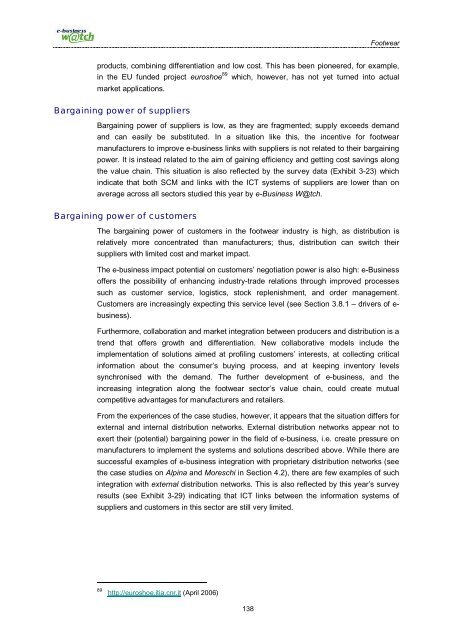Footwear Industry Footwear Industry - empirica
Footwear Industry Footwear Industry - empirica
Footwear Industry Footwear Industry - empirica
You also want an ePaper? Increase the reach of your titles
YUMPU automatically turns print PDFs into web optimized ePapers that Google loves.
<strong>Footwear</strong><br />
products, combining differentiation and low cost. This has been pioneered, for example,<br />
in the EU funded project euroshoe 89 which, however, has not yet turned into actual<br />
market applications.<br />
Bargaining power of suppliers<br />
Bargaining power of suppliers is low, as they are fragmented; supply exceeds demand<br />
and can easily be substituted. In a situation like this, the incentive for footwear<br />
manufacturers to improve e-business links with suppliers is not related to their bargaining<br />
power. It is instead related to the aim of gaining efficiency and getting cost savings along<br />
the value chain. This situation is also reflected by the survey data (Exhibit 3-23) which<br />
indicate that both SCM and links with the ICT systems of suppliers are lower than on<br />
average across all sectors studied this year by e-Business W@tch.<br />
Bargaining power of customers<br />
The bargaining power of customers in the footwear industry is high, as distribution is<br />
relatively more concentrated than manufacturers; thus, distribution can switch their<br />
suppliers with limited cost and market impact.<br />
The e-business impact potential on customers’ negotiation power is also high: e-Business<br />
offers the possibility of enhancing industry-trade relations through improved processes<br />
such as customer service, logistics, stock replenishment, and order management.<br />
Customers are increasingly expecting this service level (see Section 3.8.1 – drivers of e-<br />
business).<br />
Furthermore, collaboration and market integration between producers and distribution is a<br />
trend that offers growth and differentiation. New collaborative models include the<br />
implementation of solutions aimed at profiling customers’ interests, at collecting critical<br />
information about the consumer’s buying process, and at keeping inventory levels<br />
synchronised with the demand. The further development of e-business, and the<br />
increasing integration along the footwear sector’s value chain, could create mutual<br />
competitive advantages for manufacturers and retailers.<br />
From the experiences of the case studies, however, it appears that the situation differs for<br />
external and internal distribution networks. External distribution networks appear not to<br />
exert their (potential) bargaining power in the field of e-business, i.e. create pressure on<br />
manufacturers to implement the systems and solutions described above. While there are<br />
successful examples of e-business integration with proprietary distribution networks (see<br />
the case studies on Alpina and Moreschi in Section 4.2), there are few examples of such<br />
integration with external distribution networks. This is also reflected by this year’s survey<br />
results (see Exhibit 3-29) indicating that ICT links between the information systems of<br />
suppliers and customers in this sector are still very limited.<br />
89<br />
http://euroshoe.itia.cnr.it (April 2006)<br />
138

















